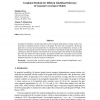139 search results - page 1 / 28 » Shortcomings with using edge encodings to represent graph st... |
GPEM
2006
13 years 5 months ago
2006
There are various representations for encoding graph structures, such as artificial neural networks (ANNs) and circuits, each with its own strengths and weaknesses. Here we analyz...
GECCO
2004
Springer
13 years 10 months ago
2004
Springer
In evolutionary algorithms a common method for encoding neural networks is to use a tree-structured assembly procedure for constructing them. Since node operators have difficulties...
VIS
2006
IEEE
14 years 6 months ago
2006
IEEE
Accurately representing higher-order singularities of vector fields defined on piecewise linear surfaces is a non-trivial problem. In this work, we introduce a concise yet complet...
JMLR
2008
13 years 5 months ago
2008
In graphical modelling, a bi-directed graph encodes marginal independences among random variables that are identified with the vertices of the graph. We show how to transform a bi...
DAM
2007
13 years 5 months ago
2007
We present a parallel algorithm for recognizing and representing a proper interval graph in O(log2 n) time with O(m + n) processors on the CREW PRAM, where m and n are the number ...

